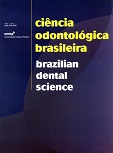Comparação da atividade antimicrobiana de soluções de peróxido de hidrogênio e malva sobre candida albicans
DOI:
https://doi.org/10.14295/bds.2009.v12i2.347Resumo
O estudo avaliou a atividade antimicrobiana de enxaguatórios bucais sobre Candida albicans. Vinte e uma amostras clínicas e uma padrão de C. albicans (ATCC 18804) foram testadas frente à enxaguatórios à base de peróxido de hidrogênio 1,5% e tintura de malva. Solução de gluconato de clorexidina 0,12% foi utilizada como controle positivo e foram obtidos valores para máxima diluição inibitória (MDI) e máxima diluição fungicida (MDF). Foram obtidas diluições seriadas dos produtos (50% a 0,02%), e adicionadas 100μL de suspensão de cada cepa e foram incubadas a 37°C/24h, e a MDI determinada. As amostras foram semeadas em ágar Sabouraud para determinação da MDF. Para a solução à base de peróxido de hidrogênio a MDI=0,78% para 86,35% das amostras e MDF=3,1% para 77,27% das amostras. Para a solução à base de gluconato de clorexidina, a MDI foi de 0,2% e 0,1% para 72,7% das amostras e MDF foi de 1,56% e 0,78% para 90,9% das amostras. Para a solução à base de tintura de malva a MDI foi de 1,56% e 0,78% para 72,72% das amostras e não houve atividade fungicida para 54,54% das amostras. A análise estatística (ANOVA Kruskal-Wallis, α=5%) mostrou diferenças significativas entre os valores médios de MDI (p=0,000) e de MDF (p=0,003). Concluiu-se que a solução à base de gluconato de clorexidina apresentou melhor atividade antimicrobiana sobre C. albicans, seguida pela solução à base de peróxido de hidrogênio. A solução à base de tintura de malva não apresentou atividade fungicida sobre a maioria das cepas de C. albicans.
Downloads
Downloads
Publicado
Como Citar
Edição
Seção
Licença
TRANSFERÊNCIA DE DIREITOS AUTORAIS E DECLARAÇÃO DE RESPONSABILIDADE
Toda a propriedade de direitos autorais do artigo "____________________________________________________________________" é transferido do autor(es) para a CIÊNCIA ODONTOLÓGICA BRASILEIRA, no caso do trabalho ser publicado. O artigo não foi publicado em outro lugar e não foi submetido simultaneamente para publicação em outra revista.
Vimos por meio deste, atestar que trabalho é original e não apresenta dados manipulados, fraude ou plágio. Fizemos contribuição científica significativa para o estudo e estamos cientes dos dados apresentados e de acordo com a versão final do artigo. Assumimos total responsabilidade pelos aspectos éticos do estudo.
Este texto deve ser impresso e assinado por todos os autores. A versão digitalizada deverá ser apresentada como arquivo suplementar durante o processo de submissão.




























